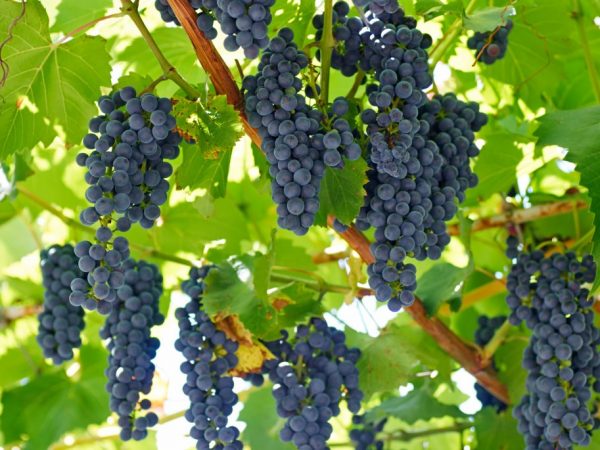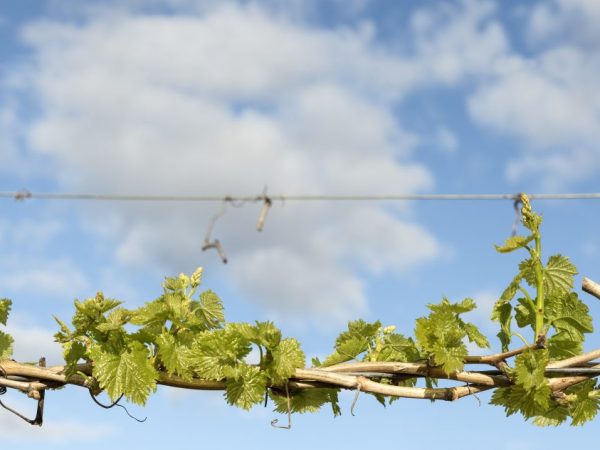Characteristics of the Marquette grape variety
Marquette grapes began to be grown in the regions of Russia not so long ago - about 10 years ago. But even in such a short time, he managed to win the hearts of domestic winemakers, thanks to its unpretentiousness and frost resistance.

Characteristics of the Marquette grape variety
Main characteristics
The variety is young, it is only 30 years old, in Russia it was started to grow a little more than 10 years ago. It was introduced by American breeders through a step-by-step crossing of 8 varieties.
Description of the bush
The Marquette grape ripens in late August and early September and has a high frost resistance. These characteristics make it possible to grow it in different regions of Russia, including the northern ones. The vines are able to withstand frost down to -38 ° C, there is no need to cover them.
The variety is vulnerable to spring frosts and freezing rains. All due to the fact that the buds on the vines open early. With the onset of spring, the bushes are covered with non-woven fiber, which protects the vines from death.
Annual seedlings require more attention. The older the bush, the better it will survive in low temperatures. Still, it is imperative to cover the bushes in early spring.
Description of fruits
According to the description, the Marquette grape variety is technical, it makes a magnificent wine of pomegranate color. The brush is dense, conical. the grapes are small, dark blue. The berries are covered with a whitish coating, which allows you to keep the brushes longer. Bunches rarely grow, about 2 pieces per vine.
Description of grapes:
- sugar content - up to 26%;
- acidity - 2.9% (although it is practically not felt by the taste);
- yield - up to 100 c / ha;
- bunch weight - about 300-400 g.
The bush grows vertically, which makes it easier to care for: the vines do not have to be tied up.
How to grow properly
Landing in the ground
The variety is easily propagated by seedlings and cuttings. Planting time does not matter, it is allowed to plant it both in spring and autumn. It is important to choose a landing site. Areas with loose soil are needed, preferably on a hill where there is no groundwater. Sandy loam and loam are excellent for seedlings. Seedlings are usually planted in a trench manner.
Landing Algorithm:
- Dig a trench about 1.5 m wide and about 1 m deep.
- Drainage is poured onto the bottom, usually a broken brick, the layer should be about 20 cm thick.
- A mixture of black soil with sand is poured on top.
- On the sides of the trench, lay 4 pieces of plastic pipe, 50 cm each, one end of each pipe must remain on the surface. It is convenient for watering and fertilizing bushes.
- The bushes are laid out in a trench at a distance of 1 m from each other.
- They are buried in earth to the second eye on the seedling.
- At the end, each bush is well watered.
- To tie the vines along the entire trench, a trellis is built. The wire strings are pulled at a distance of about 40 cm from each other.
Seedling care
Hardening

A young plant must be hardened
The vine is tender up to 3 years of age; in severe frosts, it can die - it must be hardened. The first 3 years after planting, it is better to cover the seedling, like any other grape. Long vines should be laid on boards and covered with snow.
Subsequent winters continue to warm, the layers are made thinner. This is done at a later date. If there were bushes frozen from frost, the thickness of the shelter needs to be adjusted. After 5-6 years, the vine grows stronger, it becomes unnecessary to cover it for the winter.
Pruning
Competent pruning is half the success in viticulture. You do not need to touch the bushes for 3 years. In the 4th year, they grow strongly, forming dense thickets. As a result, the bunches lack sunlight and become very small. All resources do not go into bunches, but into vines.
In the spring, 3-4 shoots appear on the seedling, one of them is chosen, the rest are cut off. A long and powerful vine is formed from this shoot.
After bud break, branches are broken off. Remove:
- barren shoots that grow at the base of the vine;
- shoots growing from one eye (leaves the most powerful);
- branches that grow weak or hard.
All barren branches should not be removed: they accumulate a supply of food for the entire vine.
In June, shoots are pinched so that the main supply of food for the bush goes to the formation of bunches.
On the fruiting branches, the sprouts are pruned, counting 5 leaves from the second bunch. It will not be superfluous to pinch the topmost vine so that it does not stretch upwards.
A dry garter is carried out in April. The overgrown branches are laid out on trellises to direct the growth of the vine. The "green garter" is made several times during the period from spring to autumn.
They also examine the vines and break off the leaves that cover the bunches. Thinning foliage provides better aeration and brushes.
In server regions of Russia, it is customary to thin out the harvest. This is done in mid-August. The smallest bunches are removed from the vine, 2 of the largest are left per vine. So they have time to ripen.
Watering
Marquette grapes do not need frequent watering. It is regularly performed during the period from bud break to the beginning of flowering and after the foliage falls.
Fertilizer
Phosphorus and nitrogenous water-soluble fertilizers are suitable for feeding the bushes. They must be liquid. The bushes need additional feeding during the period of the ovary of the bunches and their ripening. To speed up the process, the vines are sprayed with ash infusion.
Treatment against diseases and pests
If "rusty" spots, white powdery bloom appear on the leaves, the bushes are immediately treated with antifungal agents. After treatment, all affected leaves are harvested and immediately burned.
The best remedy for disease is prevention. At the initial stage of the growing season, the foliage is treated with a solution of copper sulfate. Spraying with soapy water helps well against aphids.
Wine from the Marquette grapes
The variety was bred through 8 crossing stages, so it has a rich flavor. It makes a delicious dessert and semi-sweet wine.
Wines from the Marquette grape variety are strong To create a lighter drink, winemakers mix varieties.
Marquette grapes have seeds with a bitter taste, so for wine they are crushed carefully so as not to damage them. Otherwise, the drink will taste bitter.
Conclusion
The Marquette grape variety gives the wine notes of plum, chocolate, spices, cherries and blackberries. There is a subtle aroma of tobacco and leather.
Everyone living in regions with a cold and temperate climate should take a closer look at this type of seedlings: it is easy to care for, the harvest has time to ripen even in the conditions of the North of Russia.


